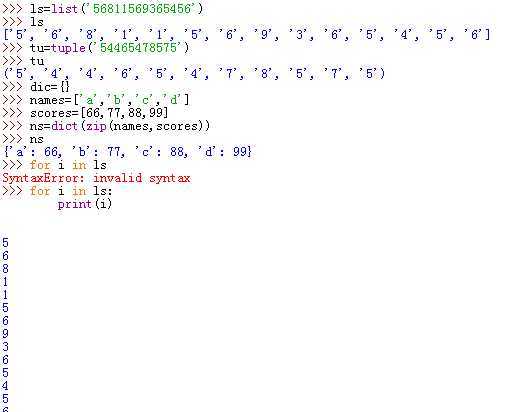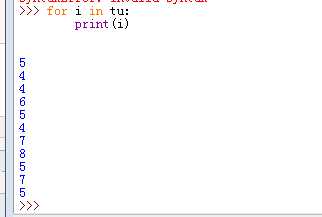标签:http items lis get core one 分析字符串 pytho pre
1,建立学生学号成绩字典,做增删改查遍历操作。
#创建
d={‘01‘:73,‘02‘:98,‘03‘:66,‘04‘:88,‘05‘:73}
d
{‘01‘: 73, ‘02‘: 98, ‘03‘: 66, ‘04‘: 88, ‘05‘: 73}
#查找
>>> d[‘04‘]
88
#插入
>>> d[‘06‘]=‘75‘
>>> d
{‘01‘: 73, ‘02‘: 98, ‘03‘: 66, ‘04‘: 88, ‘05‘: 73, ‘06‘: ‘75‘}
#弹出并删除
>>> d.pop(‘03‘)
66
>>> d
{‘01‘: 73, ‘02‘: 98, ‘04‘: 88, ‘05‘: 73, ‘06‘: ‘75‘}
#取出键
d.keys()
dict_keys([‘01‘, ‘02‘, ‘04‘, ‘05‘, ‘06‘])
#取出值
>>> d.values()
dict_values([73, 98, 88, 73, ‘75‘])
#取出键和值
>>> d.items()
dict_items([(‘01‘, 73), (‘02‘, 98), (‘04‘, 88), (‘05‘, 73), (‘06‘, ‘75‘)])
>>> print(d.get(‘03‘))
None


2,列表,元组,字典,集合的遍历。
总结列表,元组,字典,集合的联系与区别。
#列表
ls=list(‘56811569365456‘) >>> ls [‘5‘, ‘6‘, ‘8‘, ‘1‘, ‘1‘, ‘5‘, ‘6‘, ‘9‘, ‘3‘, ‘6‘, ‘5‘, ‘4‘, ‘5‘, ‘6‘] #元组 >>> tu=tuple(‘54465478575‘) >>> tu (‘5‘, ‘4‘, ‘4‘, ‘6‘, ‘5‘, ‘4‘, ‘7‘, ‘8‘, ‘5‘, ‘7‘, ‘5‘) #字典 >>> dic={} >>> names=[‘a‘,‘b‘,‘c‘,‘d‘] >>> scores=[66,77,88,99] >>> ns=dict(zip(names,scores)) >>> ns {‘a‘: 66, ‘b‘: 77, ‘c‘: 88, ‘d‘: 99} #遍历 >>> for i in ls: print(i) 5 6 8 1 1 5 6 9 3 6 5 4 5 6 >>> for i in ns: print(i,ns[i]) a 66 b 77 c 88 d 99 >>> for i in tu: print(i) 5 4 4 6 5 4 7 8 5 7 5



3,英文词频统计实例
标签:http items lis get core one 分析字符串 pytho pre
原文地址:http://www.cnblogs.com/YWEIEN/p/7595947.html